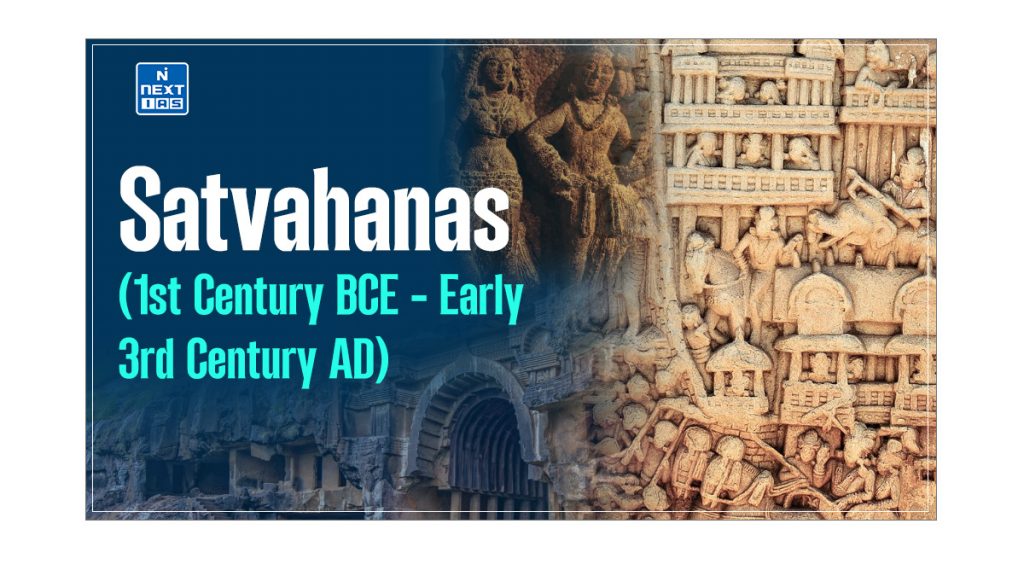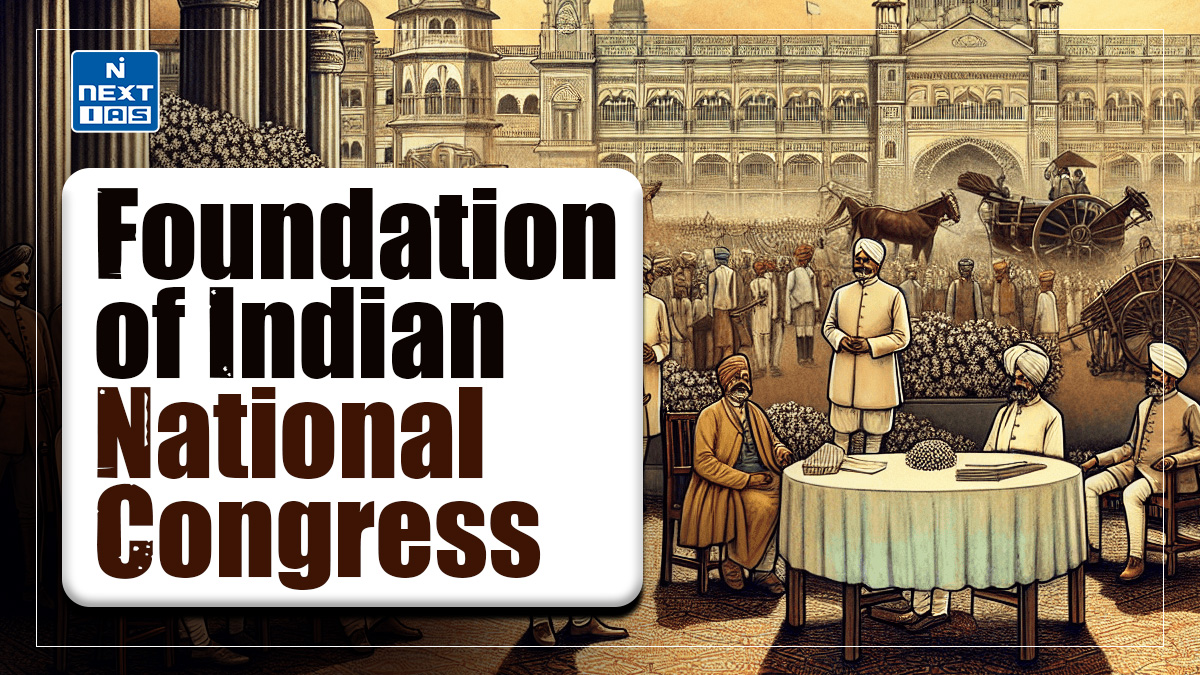
The Satvahanas Empire was a prominent ancient Indian dynasty that ruled the Deccan region from the 1st century BCE to the early 3rd century AD. Their reign was crucial in shaping the political, cultural, and economic landscape of South and Central India during a formative period in Indian history. This article aims to study in detail the origins, political history, administration, society, economy, religion, literature, and architecture of the Satvahana Empire.
About Satvahanas Dynasty
- The Satvahanas dynasty flourished between the 1st century BCE and the early 3rd century AD and was one of the most significant early Indian dynasties.
- Originating in the Deccan region, the Satvahanas established a powerful kingdom that was crucial in shaping ancient India’s political and cultural landscape.
- They are often credited with laying the foundations for developing South Indian culture.
- They were key players in the post-Mauryan period, bridging the gap between the decline of the Mauryan Empire and the rise of later South Indian powers.
Origins of Satvahanas Dynasty
- The early history of the Satvahanas is rooted in the Deccan Plateau, where they emerged as a powerful force following the fragmentation of the Mauryan Empire.
- Simuka founded the dynasty and was the first significant ruler of the Satvahanas.
- Under his leadership and successors, the Satvahanas expanded their influence, consolidating power across the Deccan and parts of central India.
- At its peak, the Satvahanas Empire’s geographical extent included significant parts of modern-day Maharashtra, Andhra Pradesh, Telangana, and Madhya Pradesh, making it a dominant power in the region.
Political History of Satvahanas Dynasty
- The political history of the Satvahanas is marked by the reigns of several notable kings, territorial expansions, and interactions with neighbouring kingdoms.
- The Satvahanas dynasty, which emerged in the northwestern Deccan around the 1st century BCE, significantly shaped the region’s history.
- With its centre at Pratishthana (modern-day Paithan in Maharashtra), the Satvahanas extended their influence over large parts of the Deccan and central India.
Major Kings and Their Reigns of Satvahanas Dynasty
- The dynasty was founded by Simuka, who established the early foundations of the Satvahana rule.
- However, the Satvahanas reached their zenith under the reign of Gautamiputra Satakarni (c. 106-130 AD).
- Gautamiputra Satakarni is remembered for his successful campaigns against the Shakas and for restoring the kingdom’s glory after a period of decline.
- Following him, Vashishtiputra Pulumavi (c. 130-154 AD) continued the expansion and consolidation of the empire, establishing his capital at Pratishthana.
Key Events and Territorial Expansion in Satvahanas Dynasty
- The Satvahanas expanded their territory significantly, extending their control over parts of Karnataka, Andhra Pradesh, and central India.
- The kingdom’s early expansion was characterised by overthrowing the Kanva dynasty, marking the Satvahanas as the successors of the Mauryas in the Deccan and central India.
- The greatest challenge to their power came from the Shakas, who, at one point, overthrew the Satvahanas. However, the kingdom was restored under Gautamiputra Satakarni, who reasserted Satvahana’s dominance.
Political Administration of Satvahanas Dynasty
- The Satvahana administration was highly organised and featured a well-defined structure.
- The territories of the Satvahanas were divided into administrative divisions known as charas.
- Various officials, such as amateurs, mahamatras, and mahasenapatis, played crucial roles in governance.
- The administration followed the guidelines of the Dharmashashtras, with the king portrayed as the upholder of Dharma, embodying qualities of mythical heroes like Rama, Bhima, and Arjuna.
- Military and feudal traits were significant in their administration. The Senapati, or chief military commander, was often appointed as the provincial governor, highlighting the militarised nature of their governance.
- The rural areas were administered by the Gaulmika, the head of the military regiment stationed there.
- The Satvahana kingdom had three grades of feudatories:
- The highest grade was formed by the Raja, who had the authority to mint coins,
- The second grade comprised the Mahabhoja,
- The third grade consisted of the Senapati.
- The Satvahanas also initiated the practice of granting tax-free villages to Brahmanas and Buddhist monks, reflecting their support for religious institutions and their role in the socio-religious landscape of the time.
Religion of Satvahanas Dynasty
- While the Satvahanas’ inscriptions assert their Brahmana identity and emphasise their performance of Vedic yajnas, the Puranas refer to them as Andhras, often described as belonging to lower social groups.
- Despite this apparent contradiction, the Satvahanas were known for their religious inclusivity.
- They generously supported Buddhist monasteries, as evidenced by numerous Brahmi script inscriptions.
- This patronage helped establish Nagarjunakonda and Amaravati in Andhra Pradesh as significant centres of Buddhist culture and learning.
- Additionally, the Satvahanas played a crucial role in promoting the spread of Buddhism in the Deccan region and beyond.
Economy of Satvahanas Dynasty
- During the Satvahana period, agriculture expanded significantly due to forest clearance and the construction of irrigation reservoirs.
- They knew the art of paddy transplantation, and the area between the Krishna and Godavari formed a great rice bowl.
- They were very famous for their cotton. Thus, they had an advanced rural economy.
- The Satvahana may have used gold as bullion or did not issue gold coins like the Kushanas. They issued mostly lead coins.
- Craft production flourished during the Satvahana period, as evidenced by archaeological discoveries at sites such as Kotalingala and epigraphic references to artisans and guilds.
- Trade with the Roman Empire grew, and the Satvahanas dominated it as they controlled the Indian Sea coast. The Periplus of the Erythraean Sea mentions two important Satvahana trade centres: Pratishthana and Tagara.
Society of Satvahanas Dynasty
- The Satvahanas originally seemed to have been a tribe of the Deccan. But eventually, they brahmanised and established the four-fold Varna system, which had fallen into disorder.
- Buddhist monks induced by land grants increasingly cultivated the indigenous tribal people. Merchants also supported them.
- Increasing trade and commerce brought many merchants and artisans to the forefront. Gandhi and the perfumers are mentioned as donors among the artisans.
- Satvahanas showed traces of matrilineal social structure. It was customary for their king to be named after their mothers, like Gautamiputra and Vishisthiputra.
- Queens made important religious gifts in their own right, and some of them acted as regents. Still, basically, the Satvahana ruling family was patriarchal because a succession of the throne went to the male members.
Literature of Satvahanas Dynasty
- The Satvahanas were notable for patronising the Prakrit language, choosing it over Sanskrit for official and literary purposes.
- Hala’s “Gatha Sattasai,” a celebrated anthology of Prakrit poetry, stands as a testament to the literary achievements of this period.
- All Satvahana inscriptions were composed in Prakrit and inscribed using the Brahmi script, reflecting their commitment to making language accessible to the broader population.
- This preference for Prakrit also highlights the Satvahanas’ efforts to preserve and promote regional languages and cultures, which played a key role in the cultural development of the Deccan.
Art and Architecture of Satvahanas Dynasty
- Many chaityas and monasteries were cut out of solid rock in the northwestern Deccan and Maharashtra.
- The two common religious constructions were Buddhist temples called chaityas and monasteries called viharas.
- A chaitya was a large hall with several columns, and a vihara consisted of a central hall entered by a doorway from the front verandah. The most famous Chaitya is that of Karle.
- Viharas were monasteries excavated near the chaityas for the residence of the monks.
- Rock-cut architecture is also found in Andhra in the Krishna-Godavari region.
- The region is also famous for individual Buddhist structures called stupas. A stupa is a long, round structure erected over a relic of the Buddha.
Conclusion
The Satvahana dynasty significantly influenced the Deccan region, contributing to its political stability, cultural richness, and religious diversity. Their patronage of Buddhism, Prakrit literature, and unique architectural styles left a lasting legacy, bridging the post-Mauryan and pre-South Indian empires. Their impact on Indian history continues to be felt in the region’s cultural and historical identity.
Frequently Asked Questions (FAQs)
Who is the founder of Satavahana Dynasty?
The founder of the Satavahana Dynasty is believed to be Simuka. He is credited with establishing the dynasty in the 1st century BCE and laying the foundation for the Satavahana rule in the Deccan region.
What is the another name of Satavahana Dynasty?
The Andhra Dynasty is another name for the Satavahana Dynasty.
Which is the emblem of the Satavahana Dynasty?
The emblem of the Satavahana Dynasty was the Ujjain symbol, consisting of four or six intersecting circles.
What is Satavahana dynasty kings?
Some of the Satavahana Dynasty kings include:
– Simuka (Founder)
– Satakarni I
– Gautamiputra Satakarni
– Vashishtiputra Pulumavi
– Yajna Sri Satakarni
What is Satavahana dynasty capital?
The Satavahana Dynasty capital was Pratishthana (modern-day Paithan in Maharashtra).
What is Satavahana dynasty time period?
The Satavahana Dynasty time period is approx 230 BCE to 220 CE.





